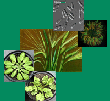| Beck, E; Fettig, S; Knake, C; Bhattarai, T; Hartig, K: Specific and unspecific responses of plants to cold and drought stress, journal of biosciences, 3(32), 501-510 (2007), doi:10.1007/s12038-007-0049-5 | |
| Abstract: Different environmental stresses to a plant may result in similar responses at the cellular and molecular level. This is due to the fact that the impacts of the stressors trigger similar strains and downstream signal transduction chains. A good example for an unspecific response is the reaction to stressors which induce water deficiency e.g. drought, salinity and cold, especially frost. The stabilizing effect of liquid water on the membrane bilayer can be supported by compatible solutes and special proteins. At the metabolic level, osmotic adjustment by synthesis of low-molecular osmolytes (carbohydrates, betains, proline) can counteract cellular dehydration and turgor loss. Taking the example of Pinus sylvestris, changes at the level of membrane composition, and concomitantly of photosynthetic capacity during frost hardening is shown. Additionally the effect of photoperiod as measured via the phytochrome system and the effect of subfreezing temperatures on the incidence of frost hardening is discussed. Extremely hydrophilic proteins such as dehydrins are common products protecting not only the biomembranes in ripening seeds (late embryogenesis abundant proteins) but accumulate also in the shoots and roots during cold adaptation, especially in drought tolerant plants. Dehydrins are characterized by conserved amino acid motifs, called the K-, Y-or S-segments. Accumulation of dehydrins can be induced not only by drought, but also by cold, salinity, treatment with abscisic acid and methyl jasmonate. Positive effects of the overexpression of a wild chickpea (Cicer pinnatifidum) dehydrin in tobacco plants on the dehydration tolerance is shown. The presentation discusses the perception of cold and drought, the subsequent signal transduction and expression of genes and their products. Differences and similarities between the plant responses to both stressors are also discussed. |

